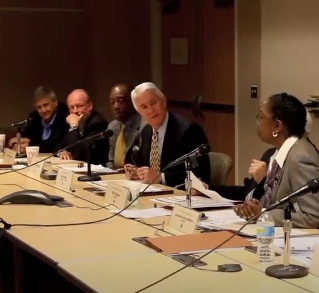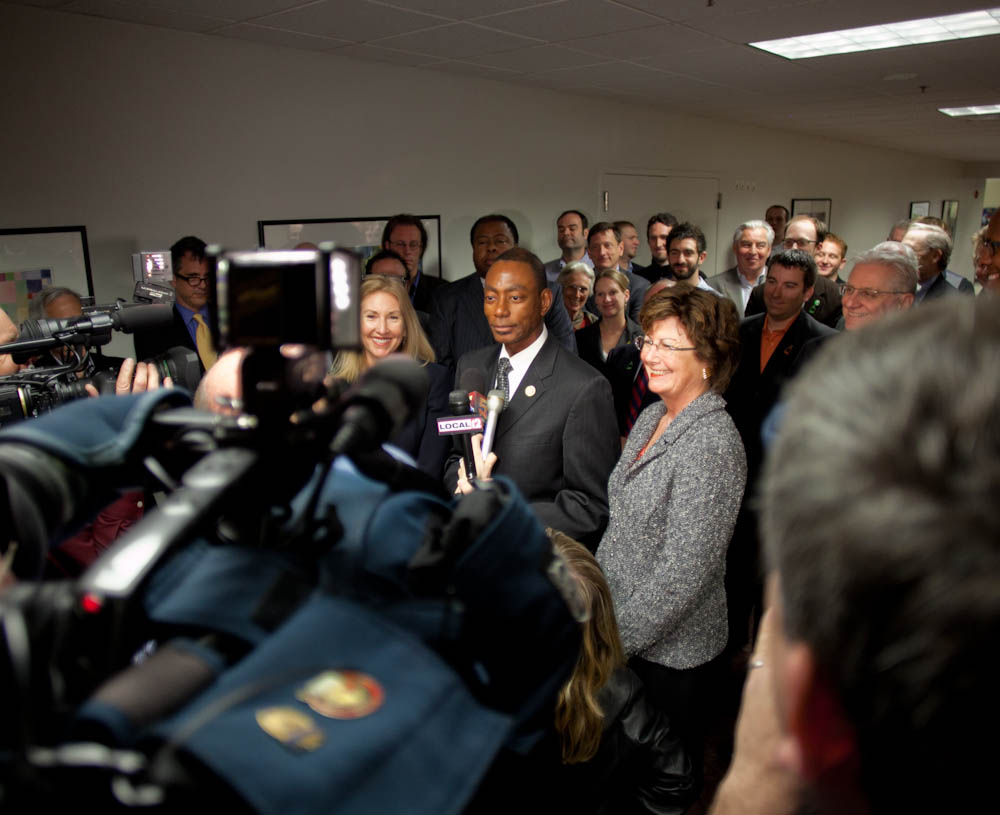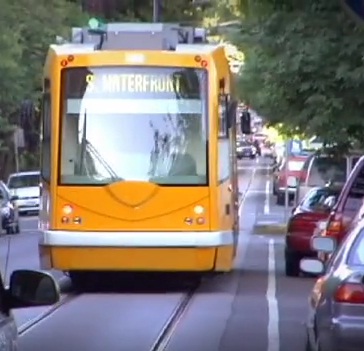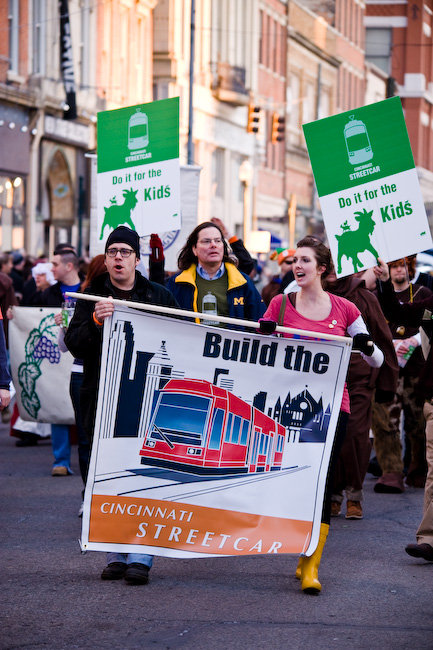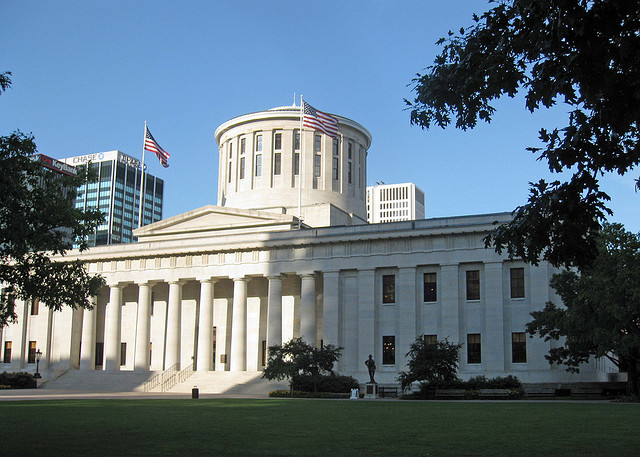In 2010 there was no reason to believe that Cincinnati’s streetcar project was in jeopardy, as all capital funds had been identified and future casino revenues were expected to cover annual operations costs. Late in the year I expressed my optimism to a seasoned local preservationist, whose terse response took me by surprise: “You guys haven’t been burned yet”.
On Tuesday April 12, Cincinnati finally got burned. ODOT’s nine-member Transportation Review Advisory Council (TRAC) approved a budget that reallocated $52 million of federal funds from the Cincinnati Streetcar project to a variety of minor upstate projects. This decision came just five months after TRAC identified Cincinnati’s streetcar as the state’s highest-ranking project.
The “burning” actually started in March, when state representative Shannon Jones (R-Springboro) introduced an amendment to Ohio’s biennial transportation bill that read, “No state or federal funds may be encumbered, transferred, or spent pursuant to this or any other appropriations act for the Cincinnati Streetcar Project.” This two-pronged attack on the state’s allocation of federal funds to Cincinnati’s streetcar project was the thinly veiled directive of John Kasich, Ohio’s newly elected Republican governor.
For those who attended the April 12, 2011 TRAC meeting at ODOT headquarters in Columbus, Kasich’s fingerprints were obvious not just by the actions of TRAC appointees, but by the language and tone of ODOT staffers. The two-hour meeting could best be described as a kangaroo court – its outcome was never in doubt, with five or more ODOT staffers and TRAC members reciting coached lines throughout.
The existence of Jones’ streetcar-killing state legislation provided cover for the day’s proceedings, but ODOT director and TRAC chair Jerry Wray and the staffers who work beneath him nevertheless concocted justification independent of what he duplicitously called “bad legislation”.
Funding for the Cincinnati Streetcar should be dropped, Wray and ODOT staffers argued, in favor of projects that promise to improve safety, especially two upstate railroad grade separation projects.
The grand orchestration of the meeting was not limited to Kasich-era appointees and ODOT staff; during public comments a fire chief remarked that five individuals had been killed at his area’s grade crossing since his service began some twenty years previous. His message was calculated: railroads are inherently unsafe, and modern streetcars, because they run on rails at-grade mixed with vehicular traffic, are dangerous to motorists and pedestrians.
A side show to this circus was the statement made by Jack Marchbanks, who was appointed to TRAC after the March 22, 2011 meeting. Other TRAC members didn’t even know his name, but he nevertheless arrived at the April 12th meeting prepared with props — a stack of CD’s and paperwork from a 2007 Columbus light rail study — to justify his vote against the Cincinnati Streetcar. Smiling, he insinuated that the legacy of the four-year Cincinnati Streetcar effort would ultimately be a similarly forgotten stack of CD’s and spiral bound reports.
Watching the morning’s proceedings like a hawk was Cincinnati mayor Mark Mallory, who has been the face of the streetcar project since 2008. As a state senator in the late 1990’s, he was involved in the legislation that established TRAC in 1997. Its formation coincided with a 6-cent increase in Ohio’s gasoline tax that added hundreds of millions to ODOT’s annual budget. TRAC intended to keep state representatives from directing pork projects to their districts, but last Tuesday Mallory was witness to its critical flaw: that TRAC’s chair is also ODOT’s director. Because Ohio’s governors appoint ODOT’s director, a sleazy appointee of Wray’s ilk is able to intimidate ODOT staff as well as shape the agenda of TRAC.
Much credit is due to Antoinette Selvey-Maddox, TRAC’s sole southwest Ohio representative. She was the only TRAC member to challenge the day’s prevailing winds – first questioning if there was any precedent for the state legislation that blocks state allocations of federal funds to the Cincinnati Streetcar, then introducing a motion that would have seen a separate vote introduced to the process regarding the streetcar project.
The appearance of the motion clearly disturbed chairman Wray – he was not certain that votes were sufficient to defeat it. In short order it was defeated 4-3, but we must wonder, if the entire nine-member TRAC had been attendance, would the outcome have been different (two of TRAC’s nine members were absent from the year’s most important meeting)? A minute after the failure of her motion, Selvey-Maddox cast the only vote in opposition to TRAC’s 2011 recommendations.
The configuration of the meeting bears some description: it was held in the same small basement room where TRAC usually meets, with room for few people other than ODOT staffers, speakers, and media. The roughly 75 Cincinnatians who traveled to Columbus were seated in a nearby room, out of sight of both TRAC members and the media.
They watched the meeting on closed-circuit television, with poor audio. Apparently the microphone of Selvey-Maddox was not turned on, or was not working well, and so those in the overflow room did not come to appreciate her actions. The absurdity of this situation could not have been better scripted – an auditorium which could have accommodated everyone sat unused directly across the hallway from TRAC’s meeting room.
Approximately 75 Cincinnatians made the trip to Columbus in support of the streetcar. Speaking on behalf of the project were Mayor Mark Mallory, councilwoman Roxanne Qualls, councilwoman Laure Quinlivan, Cincinnatians for Progress officer Rob Richardson, and representatives from Christ Hospital, Sibcy Cline Realtors, Bromwell’s, and the University of Cincinnati. Opponents filled just four of ten allotted speaking slots, and no other opponents appeared to have made the trip.
Although Tuesday’s actions are a setback, Cincinnati is expected to announce a revised streetcar plan this week. With zero funding available from Hamilton County, and presumably zero available from Ohio until Kasich leaves office in 2014 or 2018, the attraction of additional public funds will be limited to direct federal grants (such as the Urban Circulators grant) and new or expanded local sources.
Videos produced by Jake Mecklenborg for UrbanCincy. More exclusive videos from UrbanCincy can be viewed on YouTube.
